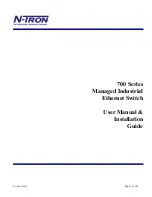
G A L A X Y ® A U R O U R A L S C O N F I G U R A T I O N A N D S Y S T E M I N T E G R A T I O N G U I D E
49
Section 3 Management
3.1.3
RAID Details
The RAID details screen is used to view information about the devices which make up a RAID,
as well as view and create LUN(s) on the RAID, and test the RAID/LUN/Drives.
At the top, we see the status of the RAID, very similar to the main screen - it shows the name
of the RAID (in this example, Bigfoot), the cache size in Megabytes (In this example, 1000
Megabytes or 1 Gigabyte), the number of cache stripes (in this example 618). The way cache
stripes are used is the stripe size (the default is 128KB) x the number of drives x the cache
stripes is the amount of RAM of the cache that is used only for data caching. The columns to
the right of cache stripes show the total capacity of the RAID (in Gigabytes – in this example,
1093 Gigabytes), the RAID Level (0 or 6), the number of devices which make up the RAID,
and the overall status of the RAID. On the left is a Delete button – this is used to delete a
RAID, however a RAID can not be deleted unless no LUN(s) exist on that RAID.
At the bottom of the RAID status table is a Scan/See Performance Stats button which takes
you to a screen where you can scan and see performance statistics for the RAID. This will be
covered later.
Below the RAID status, is a table of LUN(s), if any. A LUN is a logical portion of a RAID, which
is presented to a client system as a block device. It is logical, because a LUN only exists in the
configuration - Nothing is written to the data area of a RAID to define a LUN. In my example
above, there are no LUN(s) defined yet, so the table just says "No Luns Defined." At least one
LUN must exist in order for the array to be seen by a client.
Below the LUN table is an area where you can create a LUN. All entries must be made before
left-clicking on the Create button. To the right of the create button is an area where you can
enter the LUN name - all LUN(s) should have unique names. By default, with no size or offset,
if the LUN is created, it will be the full size of the RAID that you are creating it on, otherwise
the size entered is the size of the LUN (in Gigabytes), and the offset is where to start the LUN
(in Gigabytes). The area encompassed by a LUN can not be used by another LUN, and it
must be contiguous. For example, if you had a RAID that was 8TB, with (4) 2TB LUNs on it,
then if you deleted LUNs 1 and 3, you could not create a 4TB LUN in that space, because
LUN 2 would be in the way. Here is an example, where a single LUN was created, called
MyLun. All that was done to create this lun was “MyLun” was typed for the name, then the
















































